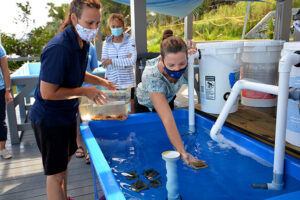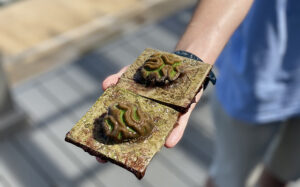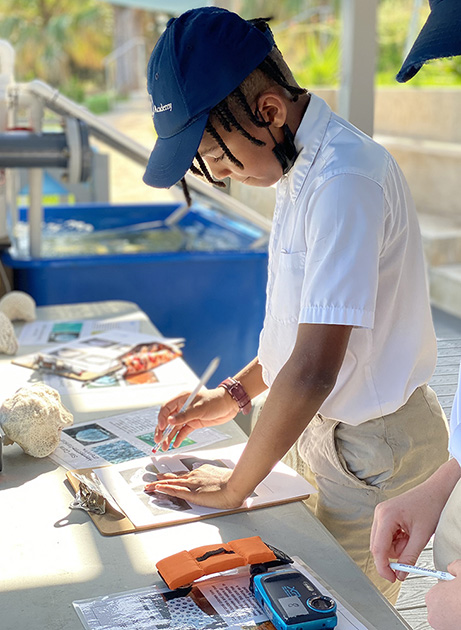BIOS and Living Reefs Foundation Bring Coral Science Into the Classroom

A partnership between BIOS, Warwick Academy, and the Living Reefs Foundation is allowing local students to participate in ongoing scientific research, learn valuable laboratory skills, and play a role in the restoration of Bermuda’s coral reefs. Earlier this month, BIOS science and education staff visited the Academy’s newly constructed Marine Science Center to deliver ten colonies of four species of Bermuda corals to Warwick Academy staff, including Science Lab Technician Rosalind Wingate (left) and Head of Science Jessica Young.
Primary and secondary students at Warwick Academy, a private school in Bermuda, now have the opportunity to participate in ongoing scientific research thanks to a partnership between BIOS, the school, and the Living Reefs Foundation (LRF), a Bermuda-based non-profit organization. The project is one of the first at the Academy’s newly-constructed waterfront Marine Science Center, allowing students to learn valuable laboratory skills and play a role in restoring coral reefs in Castle Harbor that were damaged by the development of the airport in the 1950s.
On May 31, science faculty and education staff from BIOS and LRF delivered corals to Warwick Academy staff, including Principal Dave Horan, Head of Science Jessica Young, and Science Lab Technician Rosalind Wingate. The delivery included ten colonies of four species of coral: grooved brain coral (Diploria labyrinthiformis), great star coral (Montastraea cavernosa), boulder star coral (Orbicella franksii), and mustard hill coral (Porites astreoides). These were initially grown at BIOS for coral temperature stress studies conducted by BIOS marine ecologist and biologist Samantha de Putron. Since then, the corals have been maintained and used at the Institute by a variety of BIOS interns, local education programs, and visiting groups.

The juvenile corals, which were grown at BIOS on terracotta tiles and used for a variety of scientific research and educational projects, will now be cared for by primary and secondary students at Warwick Academy. Once the corals reach a sustainable size, they will be attached to pyramid-shaped metal frames in Castle Harbour as part of the Living Reef Foundation’s Coral Garden Initiative. These frames, which are secured to the ocean floor, serve as a foundation for the young corals to grow and reproduce, offering a habitat to a variety of marine life.
“Many of our coral physiology research projects at BIOS involve the culture and fragmentation of coral colonies,” de Putron said. “We want to minimize impacts on natural reef ecosystems, so at the end of the experiments we utilize the coral pieces for other research projects or educational programs. Ultimately, we wanted to place the corals back into their natural environment, so we began a collaboration with LRF a few years ago to facilitate this and assist with their conservation efforts. Expanding this collaboration to a local school is a great way to link our research with meaningful and impactful education and conservation endeavors.”
LRF was formed in 2014 by BIOS marine biologist Samia Sarkis with the mission of keeping Bermuda’s reefs healthy and acting to restore damaged reefs. For the last five years, Sarkis, also a BIOS adjunct faculty member, has focused her efforts on a project called The Coral Garden Initiative, which leverages her relationship with BIOS scientists to investigate sustainable methods of transplanting young corals into damaged reef environments.
This current partnership uses the initial BIOS methodology, which involves growing juvenile corals on three-inch (7.5-centimeter) square terracotta tiles. LRF scientists are also investigating alternative rearing methods that mimic more natural surfaces and provide microhabitats for young corals to offer optimal growth conditions. Once the corals grow to a sustainable size, the growing surfaces (including the terracotta tiles) are attached to pyramid-shaped metal frames in Castle Harbour. These frames, which are secured to the ocean floor, serve as a foundation for the young corals to grow and reproduce, offering a habitat to a variety of marine life.
“It’s a great opportunity for school-age children to understand that it is in our capacity to remedy damage on reefs caused by coastal development or boat groundings,” Sarkis said. “We don’t have to sit back and hope for the best; we can act. Coral growth in our gardens so far demonstrates success in our approach, and scaling up these efforts can hold great promise for long term preservation of our reefs.”
A Longstanding Partnership Comes to Fruition
Young has been working with BIOS since 2006, participating in professional development workshops, field trips, and—most recently—bringing her school onboard for the annual MARINE remotely operated vehicle (ROV) contest. Young also teaches Warwick Academy’s International Baccalaureate (IB)-level environmental systems course and often includes BIOS field trips as a component of her classes due to its “rigorous standards for data analysis and collections.”
When Horan asked Young about the possibility of constructing a wet-lab facility at the school, she immediately saw an opportunity to give students, as well as community members and Bermuda College students, a variety of hands-on, experiential-learning programs that “actually immerse them in the environment to make a much-needed personal connection.” She reached out to Kaitlin Noyes, BIOS’s director of education and community engagement, with whom she had been working closely with for a number of years (Noyes leads the MARINE ROV Challenge, among other education programs at BIOS). Noyes helped Young obtain the necessary equipment, as well as the permits for holding live corals at the science center.
“I’m excited to finally realize this holistic endeavor between BIOS, the Living Reefs Foundation, and Warwick Academy,” Young said. “If we encourage kids to get involved from a young age, especially in this era of climate change, we inspire future ambassadors of the ocean. The wonderful thing about this partnership is that our students are now guardians for the corals, until such time as they are transplanted. They can be involved in their care and monitoring of water quality, and the corals can be used as cross-curricular links. Hopefully students will gain a good understanding of the role the ocean plays in the support of living systems.”

The living corals at the Warwick Academy Marine Science Center offer students an opportunity to become involved in their care by monitoring water quality and cleaning tanks. “Our students are now guardians for the corals,” Young said, “and the corals can be used as cross-curricular links.” Recently, BIOS education staff visited the school to teach hands-on lessons in coral biology and identification, as well as how scientists study corals underwater.
Putting the Pieces Together
On June 15 and 16, Noyes, BIOS science education officer Claire Fox, and dive safety officer Kyla Smith returned to Warwick Academy’s Marine Science Center to teach a short course for the Year 6 (grade 5) science class using the newly donated corals as a jumping off point. Topics covered over the 90-minute lesson included an introduction to coral biology and an explanation of the most common coral species in Bermuda. Students practiced matching donated coral skeletons to the living corals using underwater cameras and watched a SCUBA diving demonstration that included common scientific tools and techniques used to study coral reefs.
“The enthusiasm and excitement of the students for learning about Bermuda’s coral reefs was very rewarding, and having the live specimens now at the facility allowed us to bring the whole lesson to life,” Noyes said. “Our education team is excited to have the opportunity to interact with Warwick Academy students and other schools utilizing the resources at the Warwick Academy Marine Science Center.”
Once the corals grow large enough, Sarkis will work with Young to provide Warwick Academy students with an opportunity to “plant” their home-grown corals on the LRF coral gardens. This gives students the chance to see a real-world scientific project from beginning to end, including how Bermuda’s reef conservation benefitted from their efforts.
